International Trade Theory and Policy: Recession Impact on India
VerifiedAdded on 2023/06/15
|24
|4654
|71
Essay
AI Summary
This essay analyzes the impact of the 2008-2009 global recession on international trade, with a specific focus on India. It discusses the great recession period, its effects on weakening the global economic environment, and the increasing vulnerability of developing countries. The study highlights India's experience during the recession, including the trade collapse and its impact on major sectors. It further explores the declining global trade and industrial production during this period, emphasizing the interconnectedness of global economies and the specific challenges faced by India due to its reliance on exports and integration with international markets. The essay concludes that while India was somewhat insulated due to its less integrated financial sector, the real economy experienced significant negative impacts from collapsing capital flows and reduced foreign trade.
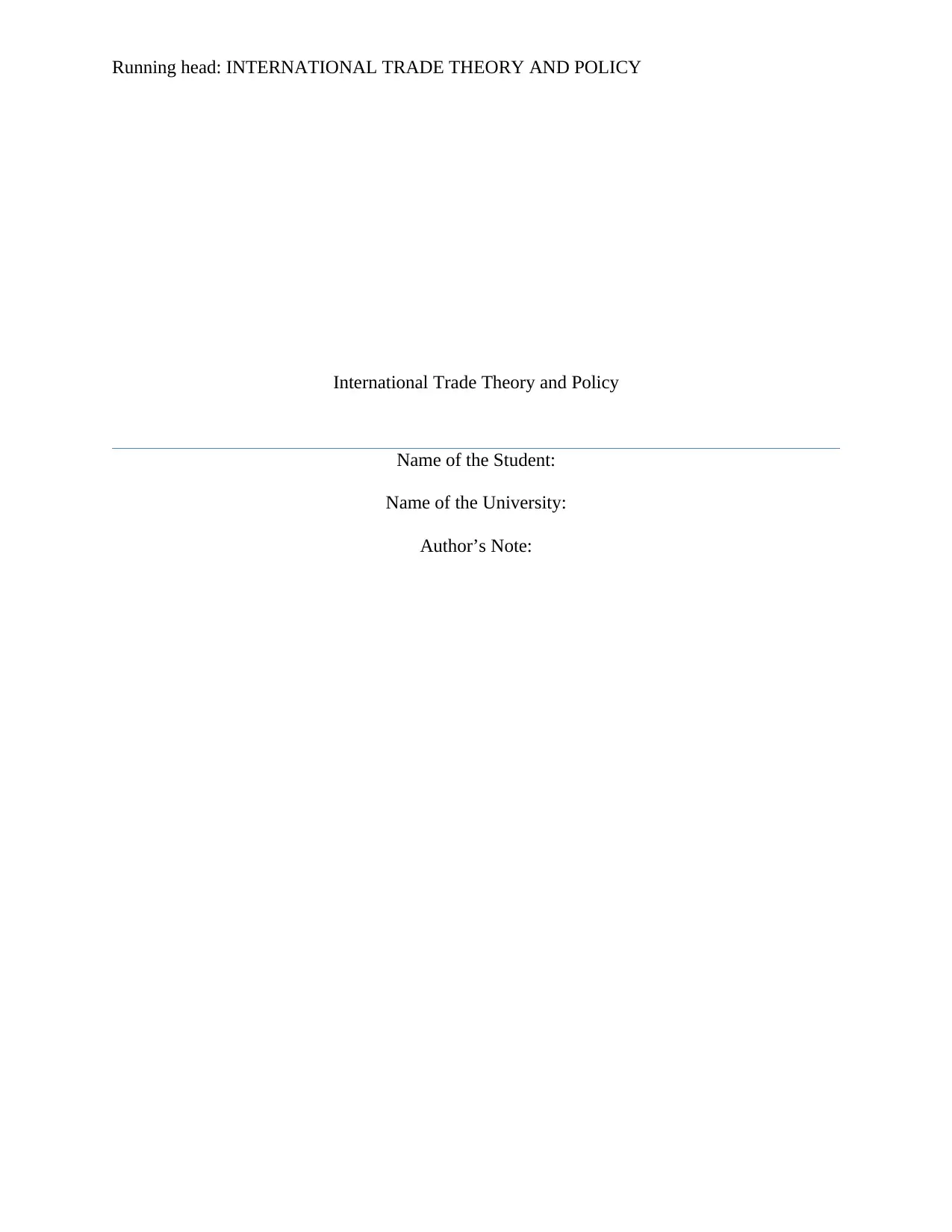
Running head: INTERNATIONAL TRADE THEORY AND POLICY
International Trade Theory and Policy
Name of the Student:
Name of the University:
Author’s Note:
International Trade Theory and Policy
Name of the Student:
Name of the University:
Author’s Note:
Paraphrase This Document
Need a fresh take? Get an instant paraphrase of this document with our AI Paraphraser
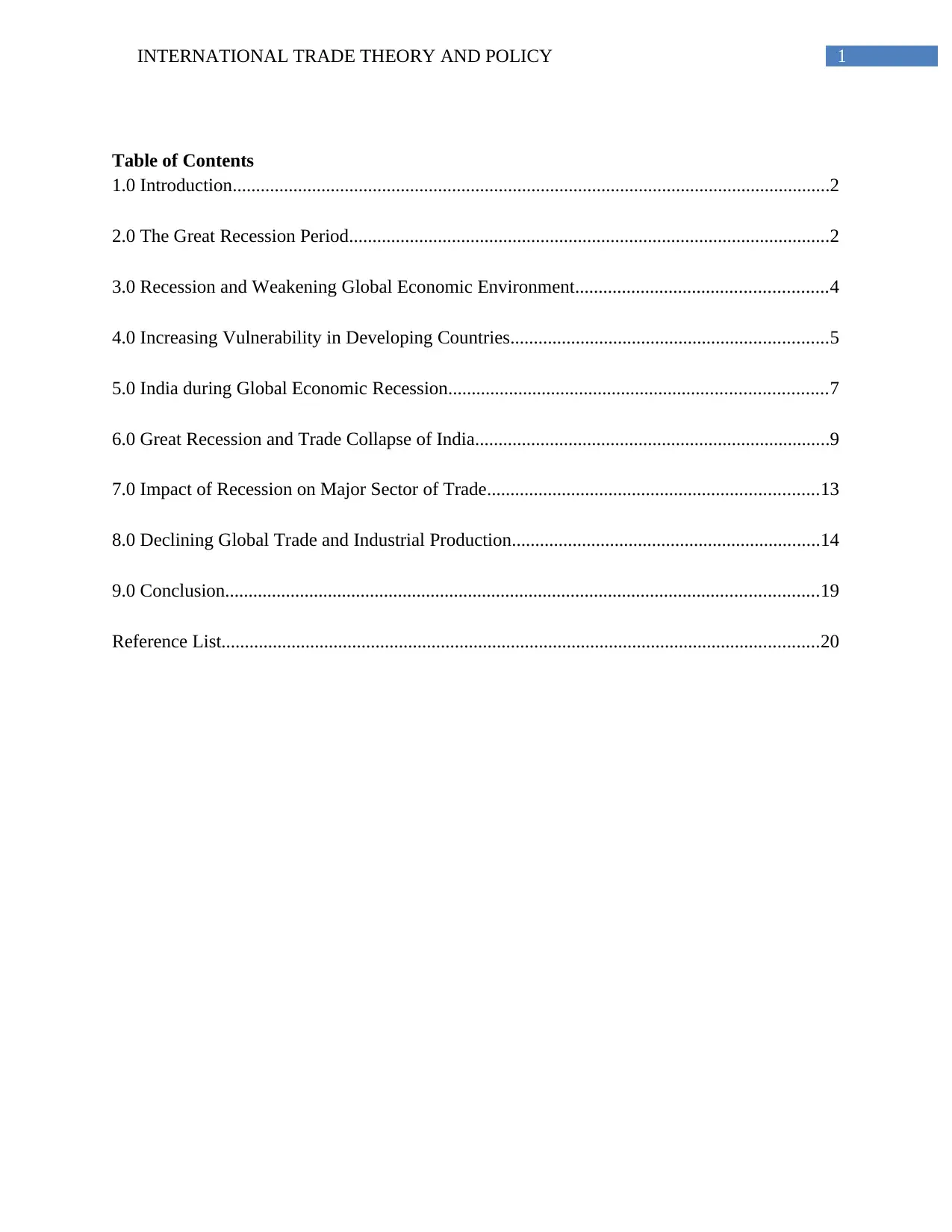
1INTERNATIONAL TRADE THEORY AND POLICY
Table of Contents
1.0 Introduction................................................................................................................................2
2.0 The Great Recession Period.......................................................................................................2
3.0 Recession and Weakening Global Economic Environment......................................................4
4.0 Increasing Vulnerability in Developing Countries....................................................................5
5.0 India during Global Economic Recession.................................................................................7
6.0 Great Recession and Trade Collapse of India............................................................................9
7.0 Impact of Recession on Major Sector of Trade.......................................................................13
8.0 Declining Global Trade and Industrial Production..................................................................14
9.0 Conclusion...............................................................................................................................19
Reference List................................................................................................................................20
Table of Contents
1.0 Introduction................................................................................................................................2
2.0 The Great Recession Period.......................................................................................................2
3.0 Recession and Weakening Global Economic Environment......................................................4
4.0 Increasing Vulnerability in Developing Countries....................................................................5
5.0 India during Global Economic Recession.................................................................................7
6.0 Great Recession and Trade Collapse of India............................................................................9
7.0 Impact of Recession on Major Sector of Trade.......................................................................13
8.0 Declining Global Trade and Industrial Production..................................................................14
9.0 Conclusion...............................................................................................................................19
Reference List................................................................................................................................20
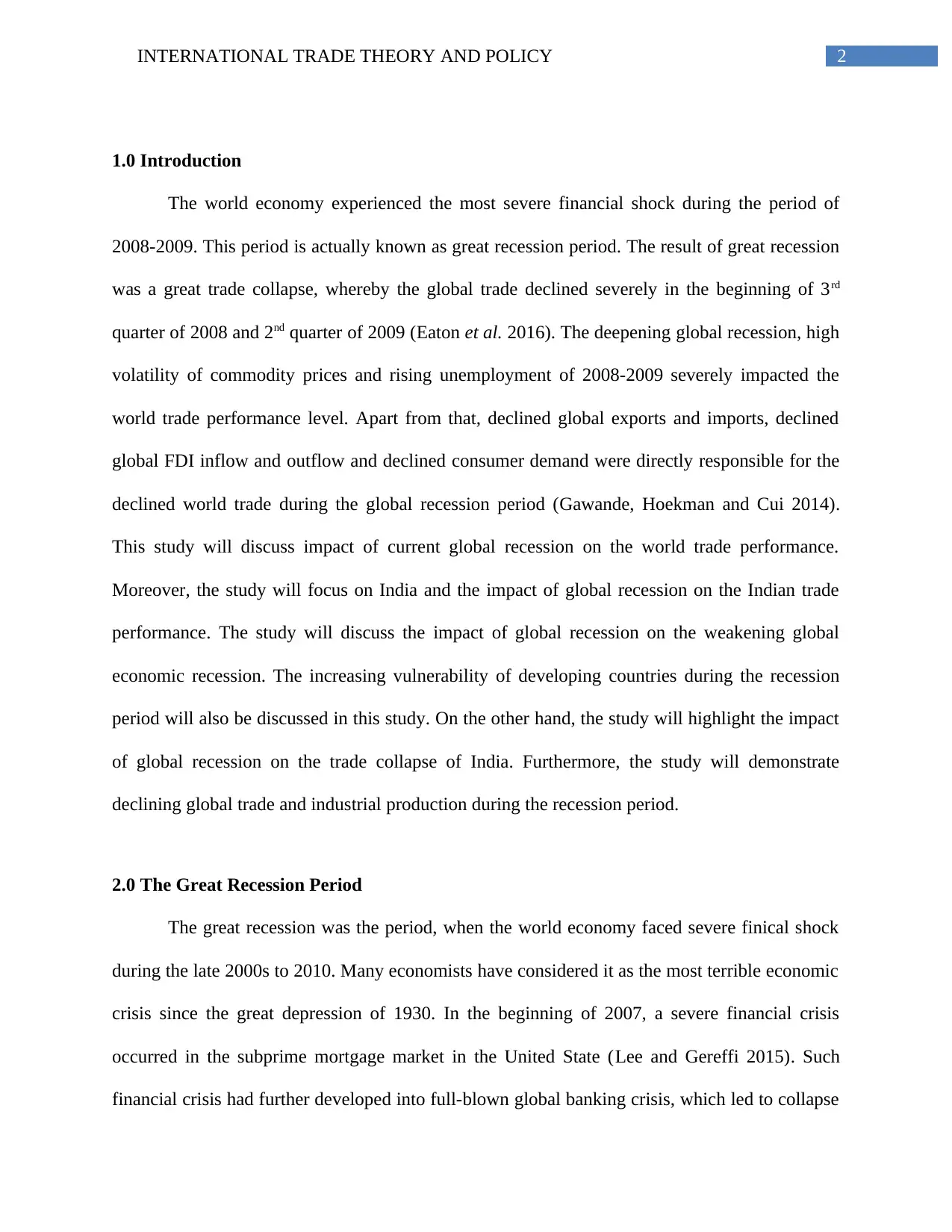
2INTERNATIONAL TRADE THEORY AND POLICY
1.0 Introduction
The world economy experienced the most severe financial shock during the period of
2008-2009. This period is actually known as great recession period. The result of great recession
was a great trade collapse, whereby the global trade declined severely in the beginning of 3rd
quarter of 2008 and 2nd quarter of 2009 (Eaton et al. 2016). The deepening global recession, high
volatility of commodity prices and rising unemployment of 2008-2009 severely impacted the
world trade performance level. Apart from that, declined global exports and imports, declined
global FDI inflow and outflow and declined consumer demand were directly responsible for the
declined world trade during the global recession period (Gawande, Hoekman and Cui 2014).
This study will discuss impact of current global recession on the world trade performance.
Moreover, the study will focus on India and the impact of global recession on the Indian trade
performance. The study will discuss the impact of global recession on the weakening global
economic recession. The increasing vulnerability of developing countries during the recession
period will also be discussed in this study. On the other hand, the study will highlight the impact
of global recession on the trade collapse of India. Furthermore, the study will demonstrate
declining global trade and industrial production during the recession period.
2.0 The Great Recession Period
The great recession was the period, when the world economy faced severe finical shock
during the late 2000s to 2010. Many economists have considered it as the most terrible economic
crisis since the great depression of 1930. In the beginning of 2007, a severe financial crisis
occurred in the subprime mortgage market in the United State (Lee and Gereffi 2015). Such
financial crisis had further developed into full-blown global banking crisis, which led to collapse
1.0 Introduction
The world economy experienced the most severe financial shock during the period of
2008-2009. This period is actually known as great recession period. The result of great recession
was a great trade collapse, whereby the global trade declined severely in the beginning of 3rd
quarter of 2008 and 2nd quarter of 2009 (Eaton et al. 2016). The deepening global recession, high
volatility of commodity prices and rising unemployment of 2008-2009 severely impacted the
world trade performance level. Apart from that, declined global exports and imports, declined
global FDI inflow and outflow and declined consumer demand were directly responsible for the
declined world trade during the global recession period (Gawande, Hoekman and Cui 2014).
This study will discuss impact of current global recession on the world trade performance.
Moreover, the study will focus on India and the impact of global recession on the Indian trade
performance. The study will discuss the impact of global recession on the weakening global
economic recession. The increasing vulnerability of developing countries during the recession
period will also be discussed in this study. On the other hand, the study will highlight the impact
of global recession on the trade collapse of India. Furthermore, the study will demonstrate
declining global trade and industrial production during the recession period.
2.0 The Great Recession Period
The great recession was the period, when the world economy faced severe finical shock
during the late 2000s to 2010. Many economists have considered it as the most terrible economic
crisis since the great depression of 1930. In the beginning of 2007, a severe financial crisis
occurred in the subprime mortgage market in the United State (Lee and Gereffi 2015). Such
financial crisis had further developed into full-blown global banking crisis, which led to collapse
⊘ This is a preview!⊘
Do you want full access?
Subscribe today to unlock all pages.

Trusted by 1+ million students worldwide
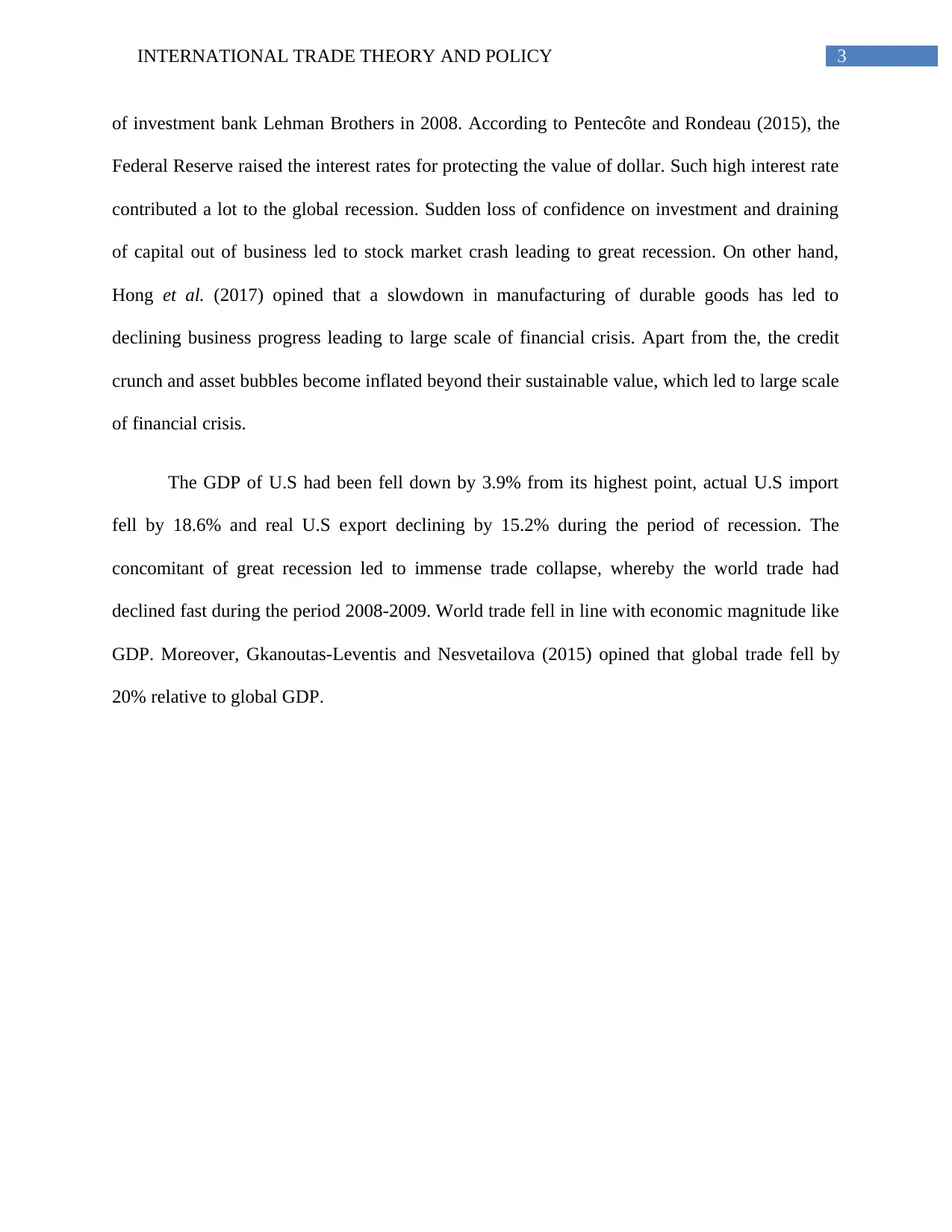
3INTERNATIONAL TRADE THEORY AND POLICY
of investment bank Lehman Brothers in 2008. According to Pentecôte and Rondeau (2015), the
Federal Reserve raised the interest rates for protecting the value of dollar. Such high interest rate
contributed a lot to the global recession. Sudden loss of confidence on investment and draining
of capital out of business led to stock market crash leading to great recession. On other hand,
Hong et al. (2017) opined that a slowdown in manufacturing of durable goods has led to
declining business progress leading to large scale of financial crisis. Apart from the, the credit
crunch and asset bubbles become inflated beyond their sustainable value, which led to large scale
of financial crisis.
The GDP of U.S had been fell down by 3.9% from its highest point, actual U.S import
fell by 18.6% and real U.S export declining by 15.2% during the period of recession. The
concomitant of great recession led to immense trade collapse, whereby the world trade had
declined fast during the period 2008-2009. World trade fell in line with economic magnitude like
GDP. Moreover, Gkanoutas-Leventis and Nesvetailova (2015) opined that global trade fell by
20% relative to global GDP.
of investment bank Lehman Brothers in 2008. According to Pentecôte and Rondeau (2015), the
Federal Reserve raised the interest rates for protecting the value of dollar. Such high interest rate
contributed a lot to the global recession. Sudden loss of confidence on investment and draining
of capital out of business led to stock market crash leading to great recession. On other hand,
Hong et al. (2017) opined that a slowdown in manufacturing of durable goods has led to
declining business progress leading to large scale of financial crisis. Apart from the, the credit
crunch and asset bubbles become inflated beyond their sustainable value, which led to large scale
of financial crisis.
The GDP of U.S had been fell down by 3.9% from its highest point, actual U.S import
fell by 18.6% and real U.S export declining by 15.2% during the period of recession. The
concomitant of great recession led to immense trade collapse, whereby the world trade had
declined fast during the period 2008-2009. World trade fell in line with economic magnitude like
GDP. Moreover, Gkanoutas-Leventis and Nesvetailova (2015) opined that global trade fell by
20% relative to global GDP.
Paraphrase This Document
Need a fresh take? Get an instant paraphrase of this document with our AI Paraphraser
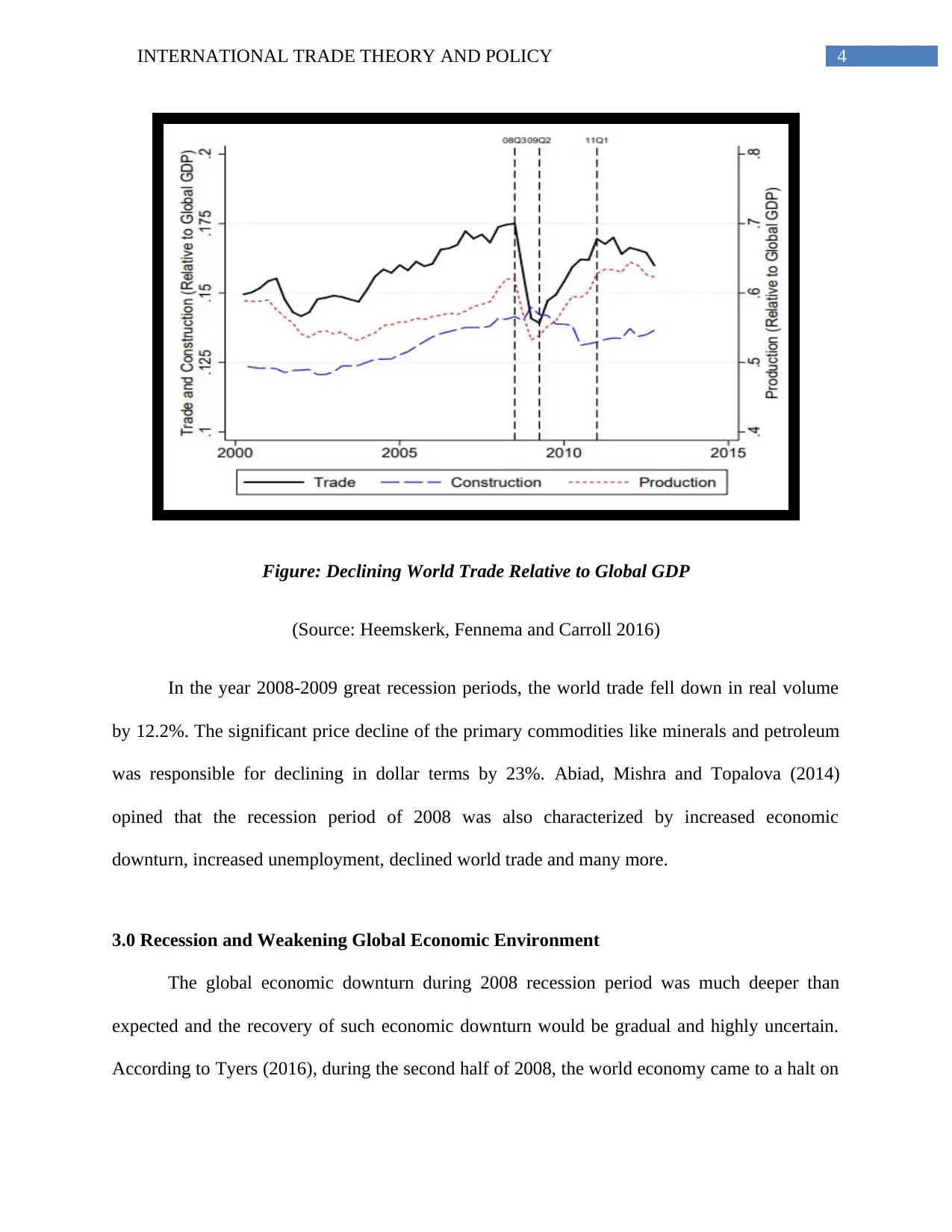
4INTERNATIONAL TRADE THEORY AND POLICY
Figure: Declining World Trade Relative to Global GDP
(Source: Heemskerk, Fennema and Carroll 2016)
In the year 2008-2009 great recession periods, the world trade fell down in real volume
by 12.2%. The significant price decline of the primary commodities like minerals and petroleum
was responsible for declining in dollar terms by 23%. Abiad, Mishra and Topalova (2014)
opined that the recession period of 2008 was also characterized by increased economic
downturn, increased unemployment, declined world trade and many more.
3.0 Recession and Weakening Global Economic Environment
The global economic downturn during 2008 recession period was much deeper than
expected and the recovery of such economic downturn would be gradual and highly uncertain.
According to Tyers (2016), during the second half of 2008, the world economy came to a halt on
Figure: Declining World Trade Relative to Global GDP
(Source: Heemskerk, Fennema and Carroll 2016)
In the year 2008-2009 great recession periods, the world trade fell down in real volume
by 12.2%. The significant price decline of the primary commodities like minerals and petroleum
was responsible for declining in dollar terms by 23%. Abiad, Mishra and Topalova (2014)
opined that the recession period of 2008 was also characterized by increased economic
downturn, increased unemployment, declined world trade and many more.
3.0 Recession and Weakening Global Economic Environment
The global economic downturn during 2008 recession period was much deeper than
expected and the recovery of such economic downturn would be gradual and highly uncertain.
According to Tyers (2016), during the second half of 2008, the world economy came to a halt on
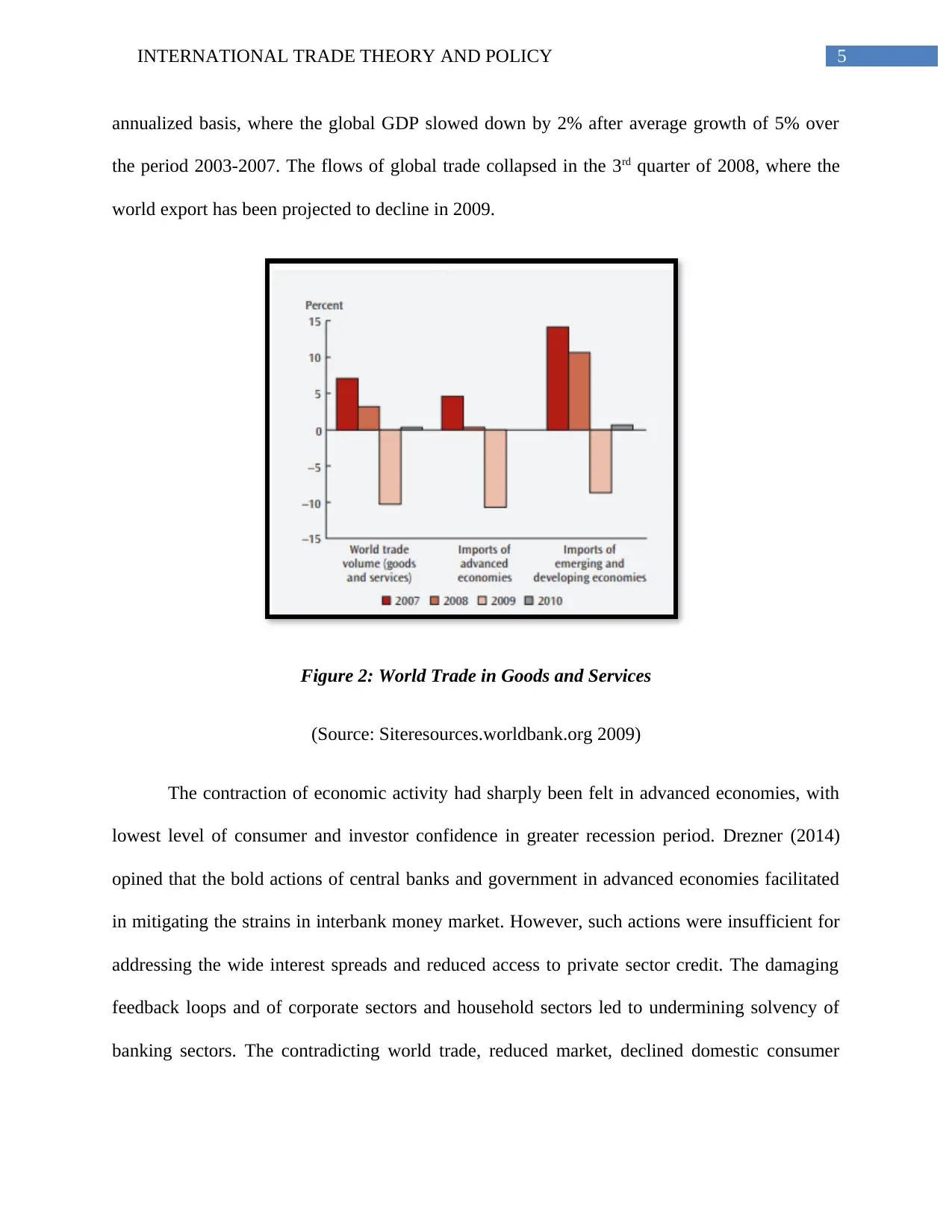
5INTERNATIONAL TRADE THEORY AND POLICY
annualized basis, where the global GDP slowed down by 2% after average growth of 5% over
the period 2003-2007. The flows of global trade collapsed in the 3rd quarter of 2008, where the
world export has been projected to decline in 2009.
Figure 2: World Trade in Goods and Services
(Source: Siteresources.worldbank.org 2009)
The contraction of economic activity had sharply been felt in advanced economies, with
lowest level of consumer and investor confidence in greater recession period. Drezner (2014)
opined that the bold actions of central banks and government in advanced economies facilitated
in mitigating the strains in interbank money market. However, such actions were insufficient for
addressing the wide interest spreads and reduced access to private sector credit. The damaging
feedback loops and of corporate sectors and household sectors led to undermining solvency of
banking sectors. The contradicting world trade, reduced market, declined domestic consumer
annualized basis, where the global GDP slowed down by 2% after average growth of 5% over
the period 2003-2007. The flows of global trade collapsed in the 3rd quarter of 2008, where the
world export has been projected to decline in 2009.
Figure 2: World Trade in Goods and Services
(Source: Siteresources.worldbank.org 2009)
The contraction of economic activity had sharply been felt in advanced economies, with
lowest level of consumer and investor confidence in greater recession period. Drezner (2014)
opined that the bold actions of central banks and government in advanced economies facilitated
in mitigating the strains in interbank money market. However, such actions were insufficient for
addressing the wide interest spreads and reduced access to private sector credit. The damaging
feedback loops and of corporate sectors and household sectors led to undermining solvency of
banking sectors. The contradicting world trade, reduced market, declined domestic consumer
⊘ This is a preview!⊘
Do you want full access?
Subscribe today to unlock all pages.

Trusted by 1+ million students worldwide
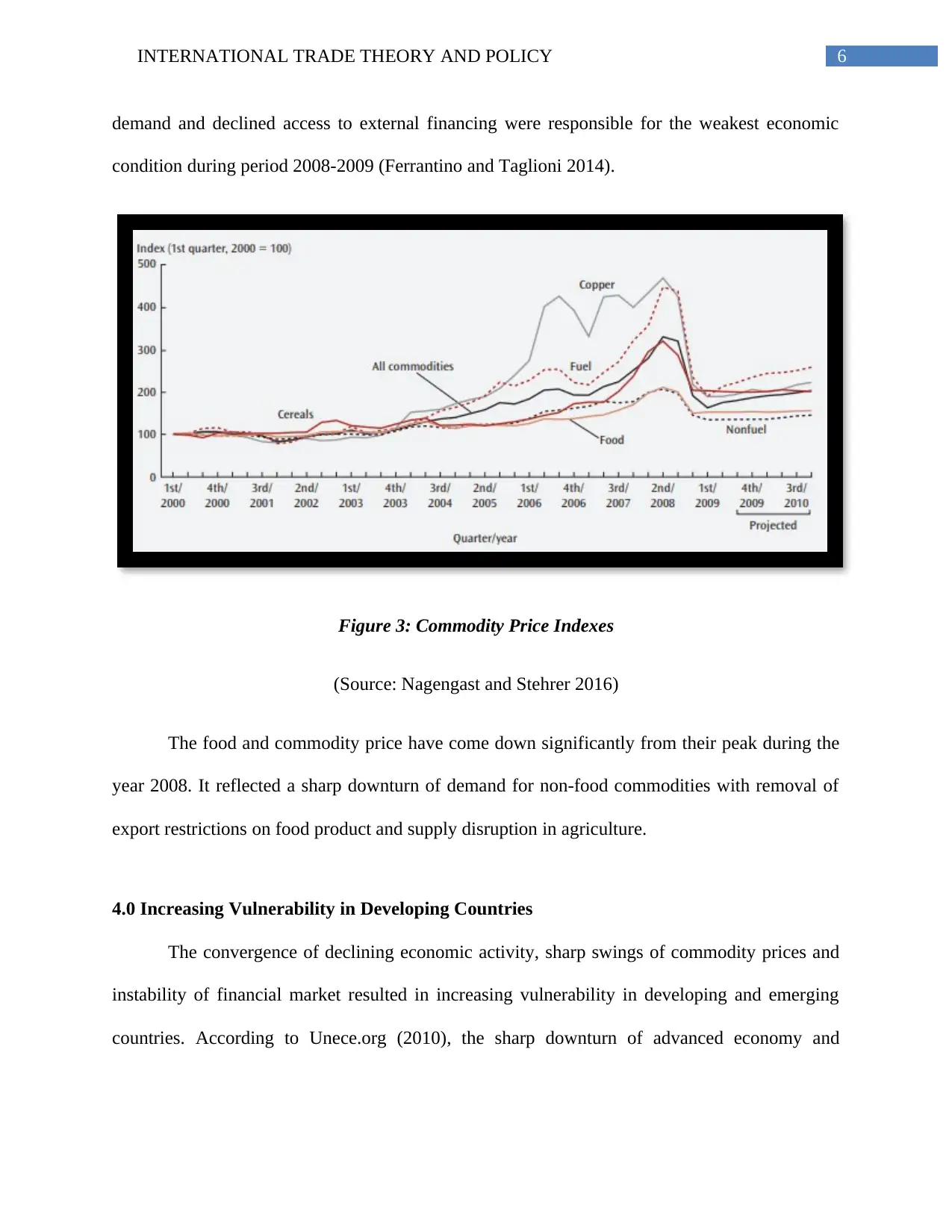
6INTERNATIONAL TRADE THEORY AND POLICY
demand and declined access to external financing were responsible for the weakest economic
condition during period 2008-2009 (Ferrantino and Taglioni 2014).
Figure 3: Commodity Price Indexes
(Source: Nagengast and Stehrer 2016)
The food and commodity price have come down significantly from their peak during the
year 2008. It reflected a sharp downturn of demand for non-food commodities with removal of
export restrictions on food product and supply disruption in agriculture.
4.0 Increasing Vulnerability in Developing Countries
The convergence of declining economic activity, sharp swings of commodity prices and
instability of financial market resulted in increasing vulnerability in developing and emerging
countries. According to Unece.org (2010), the sharp downturn of advanced economy and
demand and declined access to external financing were responsible for the weakest economic
condition during period 2008-2009 (Ferrantino and Taglioni 2014).
Figure 3: Commodity Price Indexes
(Source: Nagengast and Stehrer 2016)
The food and commodity price have come down significantly from their peak during the
year 2008. It reflected a sharp downturn of demand for non-food commodities with removal of
export restrictions on food product and supply disruption in agriculture.
4.0 Increasing Vulnerability in Developing Countries
The convergence of declining economic activity, sharp swings of commodity prices and
instability of financial market resulted in increasing vulnerability in developing and emerging
countries. According to Unece.org (2010), the sharp downturn of advanced economy and
Paraphrase This Document
Need a fresh take? Get an instant paraphrase of this document with our AI Paraphraser
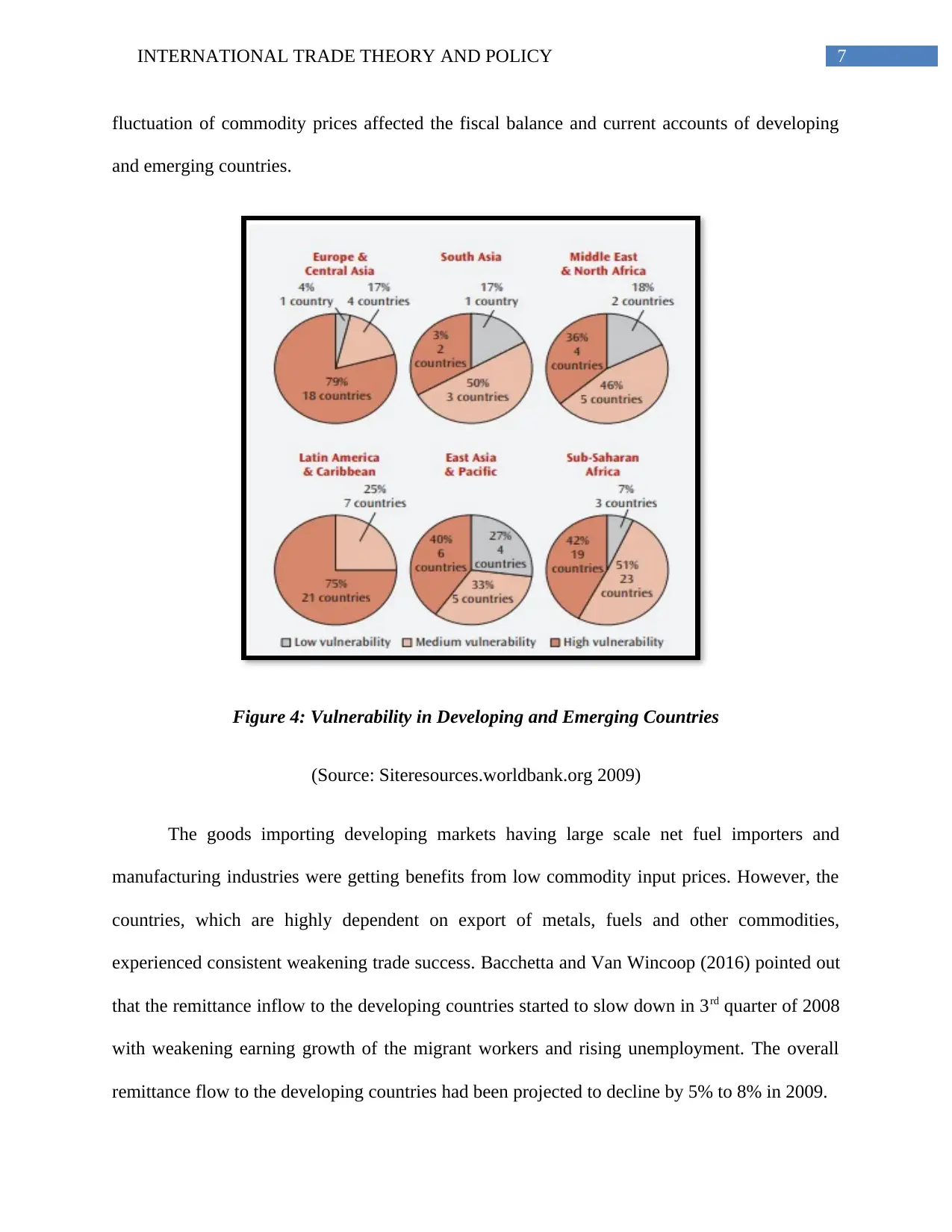
7INTERNATIONAL TRADE THEORY AND POLICY
fluctuation of commodity prices affected the fiscal balance and current accounts of developing
and emerging countries.
Figure 4: Vulnerability in Developing and Emerging Countries
(Source: Siteresources.worldbank.org 2009)
The goods importing developing markets having large scale net fuel importers and
manufacturing industries were getting benefits from low commodity input prices. However, the
countries, which are highly dependent on export of metals, fuels and other commodities,
experienced consistent weakening trade success. Bacchetta and Van Wincoop (2016) pointed out
that the remittance inflow to the developing countries started to slow down in 3rd quarter of 2008
with weakening earning growth of the migrant workers and rising unemployment. The overall
remittance flow to the developing countries had been projected to decline by 5% to 8% in 2009.
fluctuation of commodity prices affected the fiscal balance and current accounts of developing
and emerging countries.
Figure 4: Vulnerability in Developing and Emerging Countries
(Source: Siteresources.worldbank.org 2009)
The goods importing developing markets having large scale net fuel importers and
manufacturing industries were getting benefits from low commodity input prices. However, the
countries, which are highly dependent on export of metals, fuels and other commodities,
experienced consistent weakening trade success. Bacchetta and Van Wincoop (2016) pointed out
that the remittance inflow to the developing countries started to slow down in 3rd quarter of 2008
with weakening earning growth of the migrant workers and rising unemployment. The overall
remittance flow to the developing countries had been projected to decline by 5% to 8% in 2009.

8INTERNATIONAL TRADE THEORY AND POLICY
The migration from developing countries slowed down due to global economic down and
declining trade. Furthermore, the numbers of foreign employees living in destination countries
was unlikely to decrease. Hence, the countries like Middle East, North Africa, Latin America and
South Asia, who were highly dependent on remittance flow, were highly affected with this great
recession Eppinger et al. (2018). The per capita income of the people had also been adjusted with
the declining economic downturn of the countries. Hence, such weakening per capita income has
also limited the success level of the world trade with reduced spending power of the consumers.
The fuel exporting economies around the world were the hardest hit having average deterioration
of overall government balance of 10%.
Figure 5: Inflow of International Remittance
(Source: Bamiatzi et al. 2016)
5.0 India during Global Economic Recession
Indian economy is largely depended on exporting of goods to foreign markets. Being an
export dependent country, India was largely affected by the great recession period. The
stumbling industrial growth, diminishing rupee value and reduced foreign exchange led to
declining economic condition of India. According to Voxeu.org (2009), the economic instability
The migration from developing countries slowed down due to global economic down and
declining trade. Furthermore, the numbers of foreign employees living in destination countries
was unlikely to decrease. Hence, the countries like Middle East, North Africa, Latin America and
South Asia, who were highly dependent on remittance flow, were highly affected with this great
recession Eppinger et al. (2018). The per capita income of the people had also been adjusted with
the declining economic downturn of the countries. Hence, such weakening per capita income has
also limited the success level of the world trade with reduced spending power of the consumers.
The fuel exporting economies around the world were the hardest hit having average deterioration
of overall government balance of 10%.
Figure 5: Inflow of International Remittance
(Source: Bamiatzi et al. 2016)
5.0 India during Global Economic Recession
Indian economy is largely depended on exporting of goods to foreign markets. Being an
export dependent country, India was largely affected by the great recession period. The
stumbling industrial growth, diminishing rupee value and reduced foreign exchange led to
declining economic condition of India. According to Voxeu.org (2009), the economic instability
⊘ This is a preview!⊘
Do you want full access?
Subscribe today to unlock all pages.

Trusted by 1+ million students worldwide
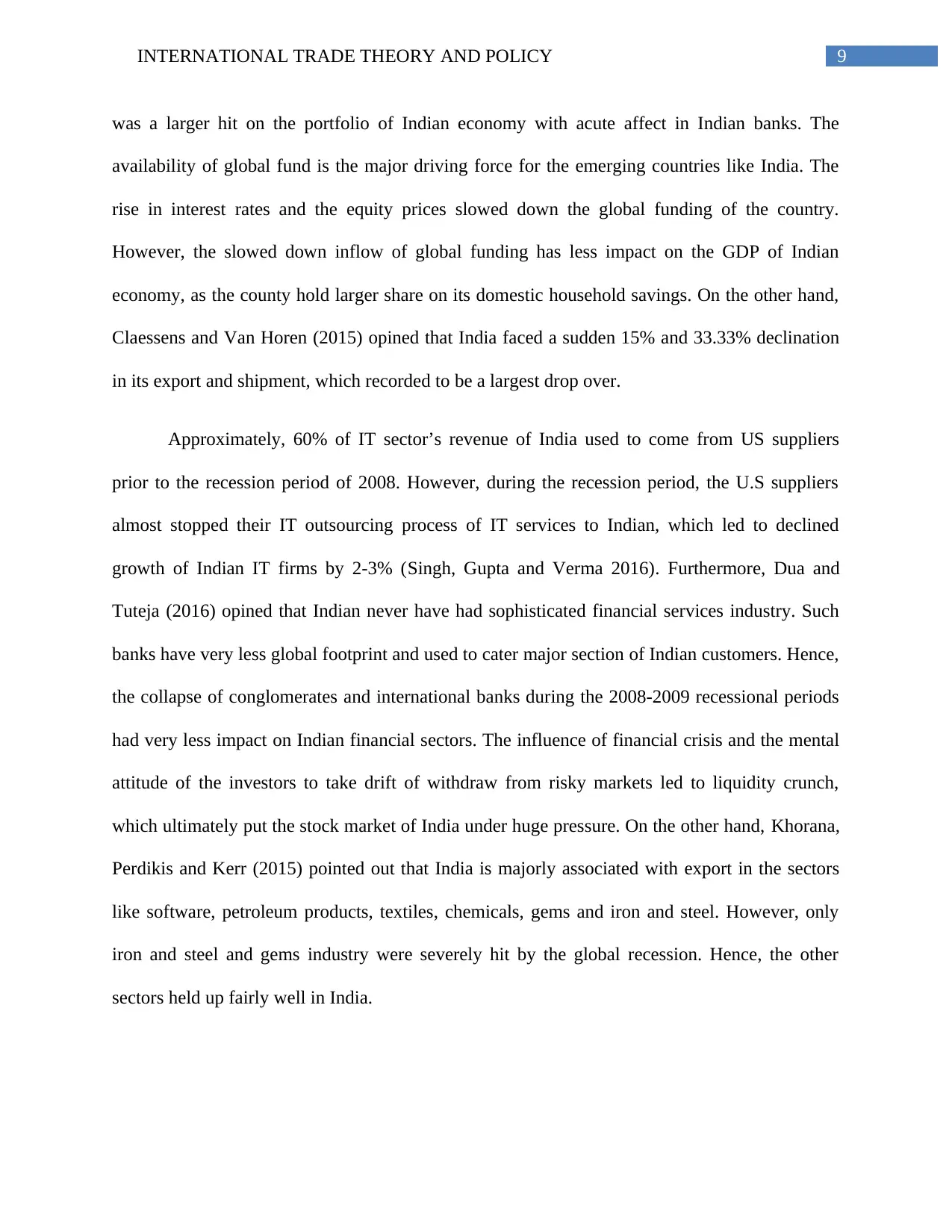
9INTERNATIONAL TRADE THEORY AND POLICY
was a larger hit on the portfolio of Indian economy with acute affect in Indian banks. The
availability of global fund is the major driving force for the emerging countries like India. The
rise in interest rates and the equity prices slowed down the global funding of the country.
However, the slowed down inflow of global funding has less impact on the GDP of Indian
economy, as the county hold larger share on its domestic household savings. On the other hand,
Claessens and Van Horen (2015) opined that India faced a sudden 15% and 33.33% declination
in its export and shipment, which recorded to be a largest drop over.
Approximately, 60% of IT sector’s revenue of India used to come from US suppliers
prior to the recession period of 2008. However, during the recession period, the U.S suppliers
almost stopped their IT outsourcing process of IT services to Indian, which led to declined
growth of Indian IT firms by 2-3% (Singh, Gupta and Verma 2016). Furthermore, Dua and
Tuteja (2016) opined that Indian never have had sophisticated financial services industry. Such
banks have very less global footprint and used to cater major section of Indian customers. Hence,
the collapse of conglomerates and international banks during the 2008-2009 recessional periods
had very less impact on Indian financial sectors. The influence of financial crisis and the mental
attitude of the investors to take drift of withdraw from risky markets led to liquidity crunch,
which ultimately put the stock market of India under huge pressure. On the other hand, Khorana,
Perdikis and Kerr (2015) pointed out that India is majorly associated with export in the sectors
like software, petroleum products, textiles, chemicals, gems and iron and steel. However, only
iron and steel and gems industry were severely hit by the global recession. Hence, the other
sectors held up fairly well in India.
was a larger hit on the portfolio of Indian economy with acute affect in Indian banks. The
availability of global fund is the major driving force for the emerging countries like India. The
rise in interest rates and the equity prices slowed down the global funding of the country.
However, the slowed down inflow of global funding has less impact on the GDP of Indian
economy, as the county hold larger share on its domestic household savings. On the other hand,
Claessens and Van Horen (2015) opined that India faced a sudden 15% and 33.33% declination
in its export and shipment, which recorded to be a largest drop over.
Approximately, 60% of IT sector’s revenue of India used to come from US suppliers
prior to the recession period of 2008. However, during the recession period, the U.S suppliers
almost stopped their IT outsourcing process of IT services to Indian, which led to declined
growth of Indian IT firms by 2-3% (Singh, Gupta and Verma 2016). Furthermore, Dua and
Tuteja (2016) opined that Indian never have had sophisticated financial services industry. Such
banks have very less global footprint and used to cater major section of Indian customers. Hence,
the collapse of conglomerates and international banks during the 2008-2009 recessional periods
had very less impact on Indian financial sectors. The influence of financial crisis and the mental
attitude of the investors to take drift of withdraw from risky markets led to liquidity crunch,
which ultimately put the stock market of India under huge pressure. On the other hand, Khorana,
Perdikis and Kerr (2015) pointed out that India is majorly associated with export in the sectors
like software, petroleum products, textiles, chemicals, gems and iron and steel. However, only
iron and steel and gems industry were severely hit by the global recession. Hence, the other
sectors held up fairly well in India.
Paraphrase This Document
Need a fresh take? Get an instant paraphrase of this document with our AI Paraphraser
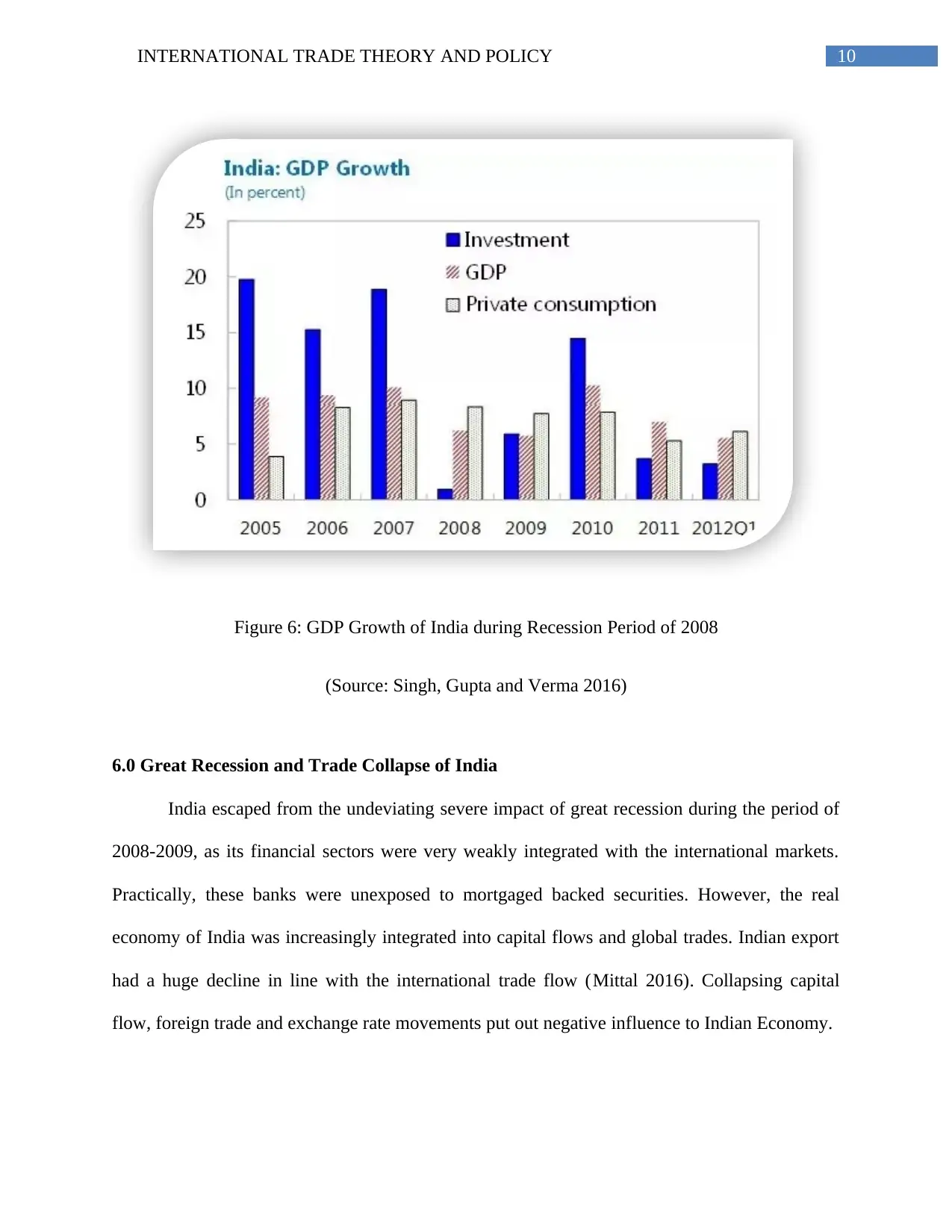
10INTERNATIONAL TRADE THEORY AND POLICY
Figure 6: GDP Growth of India during Recession Period of 2008
(Source: Singh, Gupta and Verma 2016)
6.0 Great Recession and Trade Collapse of India
India escaped from the undeviating severe impact of great recession during the period of
2008-2009, as its financial sectors were very weakly integrated with the international markets.
Practically, these banks were unexposed to mortgaged backed securities. However, the real
economy of India was increasingly integrated into capital flows and global trades. Indian export
had a huge decline in line with the international trade flow (Mittal 2016). Collapsing capital
flow, foreign trade and exchange rate movements put out negative influence to Indian Economy.
Figure 6: GDP Growth of India during Recession Period of 2008
(Source: Singh, Gupta and Verma 2016)
6.0 Great Recession and Trade Collapse of India
India escaped from the undeviating severe impact of great recession during the period of
2008-2009, as its financial sectors were very weakly integrated with the international markets.
Practically, these banks were unexposed to mortgaged backed securities. However, the real
economy of India was increasingly integrated into capital flows and global trades. Indian export
had a huge decline in line with the international trade flow (Mittal 2016). Collapsing capital
flow, foreign trade and exchange rate movements put out negative influence to Indian Economy.
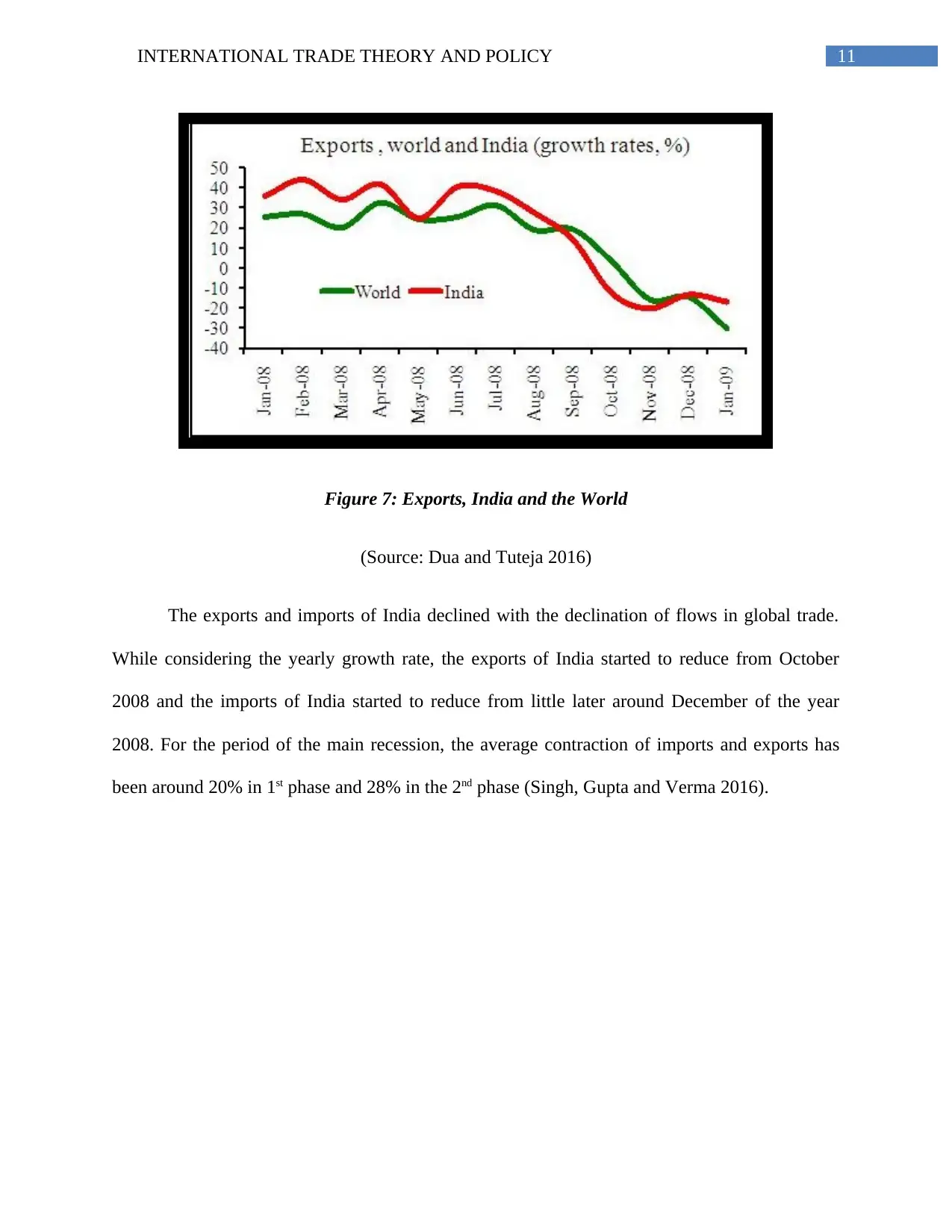
11INTERNATIONAL TRADE THEORY AND POLICY
Figure 7: Exports, India and the World
(Source: Dua and Tuteja 2016)
The exports and imports of India declined with the declination of flows in global trade.
While considering the yearly growth rate, the exports of India started to reduce from October
2008 and the imports of India started to reduce from little later around December of the year
2008. For the period of the main recession, the average contraction of imports and exports has
been around 20% in 1st phase and 28% in the 2nd phase (Singh, Gupta and Verma 2016).
Figure 7: Exports, India and the World
(Source: Dua and Tuteja 2016)
The exports and imports of India declined with the declination of flows in global trade.
While considering the yearly growth rate, the exports of India started to reduce from October
2008 and the imports of India started to reduce from little later around December of the year
2008. For the period of the main recession, the average contraction of imports and exports has
been around 20% in 1st phase and 28% in the 2nd phase (Singh, Gupta and Verma 2016).
⊘ This is a preview!⊘
Do you want full access?
Subscribe today to unlock all pages.

Trusted by 1+ million students worldwide
1 out of 24
Related Documents
Your All-in-One AI-Powered Toolkit for Academic Success.
+13062052269
info@desklib.com
Available 24*7 on WhatsApp / Email
![[object Object]](/_next/static/media/star-bottom.7253800d.svg)
Unlock your academic potential
Copyright © 2020–2025 A2Z Services. All Rights Reserved. Developed and managed by ZUCOL.





